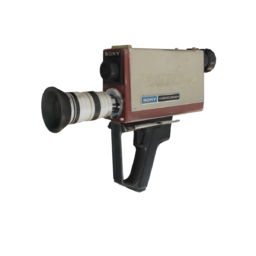Portapak

Portapak Podcast (5:38)
Note: Text in square brackets describes the soundscape as well as certain specific or occasional sounds.
[Ambience of a protest. We hear an environmental slogan sung by the demonstrators: “Save the trees! Save you and me!” The narrator is filming herself with her phone]
Narrator (in a crowd): Hey everyone! We’re live at the climate march! We’re a huge group of students in the streets, see? It’s really motivating! Wait, I’ll show you…
[Effect of wind noise, of a cell phone being handled. We can hear the crowd. Shouts, applause, slogans in chorus, etc.]
Narrator: Here’s my sign, my friend is holding it while I film… [Wind noise, cell phone manipulation] Here it is: Save the trees! Save you and me! I made it with my school’s Green Earth Club!
Hey, are you at the protest? Let me know in the comments! I have to go – but one last question: what are you doing for the environment? It’s urgent, everyone! What are you doing to change the world?
[Transition from the protest to the theme music: soft piano melody]
Narratrice : I love sharing videos about causes that are important to me. And apparently, I’m not the only one! In the 60s and 70s, video production was born in the context of important social movements. Activists and artists from all walks of life fought for women, indigenous people, and LGBTQ people, among others. Like me and my friends at the climate protest, activists from the past used video production to share information about their causes.
[Enf of theme music. Sound of a videotape rolling]
Narrator: Video production quickly became synonymous with countercultural activism. The video camera was used for more than just documenting reality – it became an important tool for social change.
[From the videotape, we hear a crowd, but it is now inside, and much quieter. We are at the Salon de la femme in 1975]
Narrator: We are now in Quebec City, in 1975 – International Women’s Year. Quebec directors Helen Doyle and Nicole Giguère are filming Philosophie de boudoir, a documentary short film at the National Women’s Show. This short film is the very first production made with Vidéo Femmes, a collective of women filmmakers that was co-founded by the directors.
Like journalists on the news, Doyle and Giguère, who are in front of the camera, share a microphone to present the event from a critical perspective. According to them, rather than promoting women’s rights, the event promotes an image of women as good housewives. The filmmakers interview several participants at the National Women’s Show. Doyle and Giguère’s interviews reveal that sexist stereotypes are very much alive. These discussions are filmed using an innovative video camera: the Portapak.
Founded in 1946 in Japan, Sony developed and produced communication technology. Since its foundation, the company has introduced a wide variety of inventions that have had a great impact on the arts and on journalism.
[Transition to a Japanese stringed instrument]
Narrator: Known as the Portapak, the Sony Video Rover II is a portable video camera introduced in 1970. This relatively lightweight device, which can be used by one person without an assistant, played a large role in the creation of community media in the 1970s.
[A film excerpt. Question by Helen Doyle: “What do you think of the Women’s Show?” Crowded atmosphere]
Narrator: The Portapak’s magnetic tape allows both image and sound to be recorded on the same medium. This innovative tape also makes it possible to film longer takes and to watch the recorded images immediately.
Before shooting, the camera operator loads the Portapak’s recorder with the magnetic tape and a battery, all placed in the camera’s shoulder bag. The camera operator plugs in his headphones and starts recording by pressing the release button. Then, waiting for the camera to heat up. And… we’re rolling! The camera operator uses the electronic viewfinder to see the frame through the camera’s eyepiece.
The Portapak produces a low definition black and white image that isn’t comparable to the cinematic standards of the time. Although the magnetic tape records a lower quality image than 16mm film, for example, this new recording medium makes it possible to erase and re-record several times on the same tape. This isn’t possible with film.
The camera operator can record for about 30 minutes. When the recording is stopped, it is possible to rewind the tape and watch the recorded images through the eyepiece whenever desired. They can even broadcast the images on a television. This innovative feature of the Portapak’s magnetic tape makes it very interesting for activist filmmakers. The ability to quickly broadcast images on community television allows artists and activists to share their views on social movements with the public.
[Transition to the narrator eating her supper in front of the television. Sound effects of a fork and knife on a plate. On TV: “Today, the environmental committee of Richelieu High School attended the climate demonstration. A young activist shared images of the demonstration with us…”]
Narrator: Hey! Mom! Dad! Come see this! They’re playing my video! [We hear the chants at the demonstration playing on TV]
Like the activist filmmakers of the 1970s, I’m on community television too! Video production really is powerful! Oh, and don’t forget… Save the trees! Save you and me!
[Theme music plays again: soft piano melody]
Narrator: To discover more cameras, listen to the other podcasts.